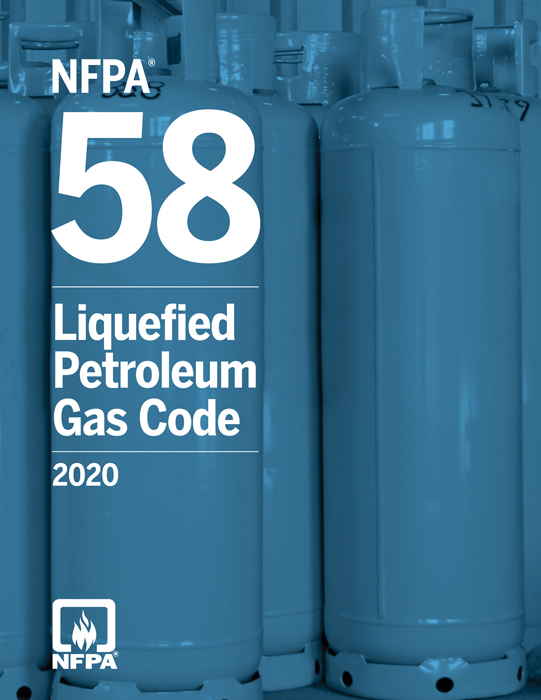Changes are coming to NFPA 58
There are some significant changes coming in the next edition of NFPA 58. It is expected to be released in late August or early September and will be the 2024 edition, having slipped from the 2023 edition largely because of COVID-19.
I am a committee member for this code. My comments do not necessarily reflect the positions or opinions of the National Fire Protection Association (NFPA). In addition, my comments reflect our thinking in North Carolina. You should consult with your authority having jurisdiction to find out how and when your state will implement the requirements.

The 2024 edition of NFPA 58 will revise the 2020 edition. When the new material drops in late August or early September, consult with your authorities having jurisdiction to determine how and when your state will implement it. (© 2019 NFPA, reproduced with permission.)
Excess-flow valves
One of the hot topics discussed this cycle involved the requirement in section 5.9.8.1(H) about sizing the excess-flow valve in a container opening to close if the piping going away from that opening fails and allows a release. The requirement is often misunderstood, and its enforcement has been inconsistent.
Depending on excess-flow valves for critical safety actions to stop flow has been debated for years, with most people saying it is not a wise choice. Section 5.9.8.1(H) will be deleted. Instead, there will be a new requirement to test internal valves and emergency shut-off valves monthly for remote shutdown activation.
The requirement to close container valves when the site is unattended continues. There is also dependance on U.S. Department of Transportation rules for attendance at transfers. It is widely believed that this combination of more frequent testing and proper monitoring of transfers is safer than depending on excess-flow valves.
Remote shutdown stations
The requirements for locating remote shutdown stations for various devices has been consolidated into a new section 4.10. Separation distances largely have been standardized and gathered into one place.
Horizontal tanks
The requirements for installation of horizontal tanks were stated in text and in tables with some inconsistencies between them. These requirements have been reorganized to better state the requirements.
Wheel stops
I wrote last year about information presented to the NFPA 58 committee concerning better placement of wheel stops for certain road situations, particularly icy conditions. No significant changes were made to the requirements, but new annex material was added to explain proper placement. This change was particularly interesting to me because the wheel stop requirement was about to be removed for trucks with air brake systems. That was reversed.
Flood maps
The U.S. Environmental Protection Agency (EPA) has been implementing new flood maps for coastal and inland rivers. Often these maps and the associated rules require either buried tanks or elevation of propane containers above the flood level. Some elevations would violate some of the code’s rules for installation heights and structures. There is no resolution presented for these conflicting requirements, but there is a new information section in the annex alerting installers of the EPA requirements and the conflicts.
Food trucks
There will be a new chapter devoted to mobile food facilities, often known as food trucks or food trailers. The task group developing the new chapter had to consider mobile food facilities from hot dog carts to semi-trailers. The semi-trailers are sometimes used to feed responder staff and volunteers at major incidents, including forest fires and hurricanes.
This new chapter 16 had its origins in the current section 6.26, LP-Gas Systems on Vehicles (Other than Engine Fuel Systems). This section is limited in its applicability to the booming mobile food facilities industry, and the need for expanded requirements became evident. NFPA 96, Standard for Ventilation Control and Fire Protection of Commercial Cooking Operations, has been designated as the lead document for mobile food facilities. They have referenced NFPA 58 for content concerning LP gas systems.
Retroactivity
There are often questions about retroactivity on new requirements. Generally, new installation requirements are not retroactive unless specifically stated. There is at least one retroactivity statement revision clarifying installation of the location of some remote shutdown stations. New action requirements are generally considered to apply to all. Thus, the new requirement for monthly testing of remote shutdown stations would have to be performed at all sites. This action should be added to your operations and maintenance manual actions. You should have a sign-off sheet for documenting the testing. But operations and maintenance manuals are a subject for a different article. Consult with your authority having jurisdiction about how they deal with new installation requirements, as some may determine that a new safety requirement justifies applying it retroactively.
Richard Fredenburg is an LP gas engineer at the North Carolina Department of Agriculture and Consumer Services, Standards Division. He is also a member of NFPA’s Technical Committee on LP Gases. Contact him at richard.fredenburg@ncagr.gov or 984-236-4752.
NOTE: The opinions and viewpoints expressed herein are solely the author’s and should in no way be interpreted as those of LP Gas magazine or any of its staff members.
















